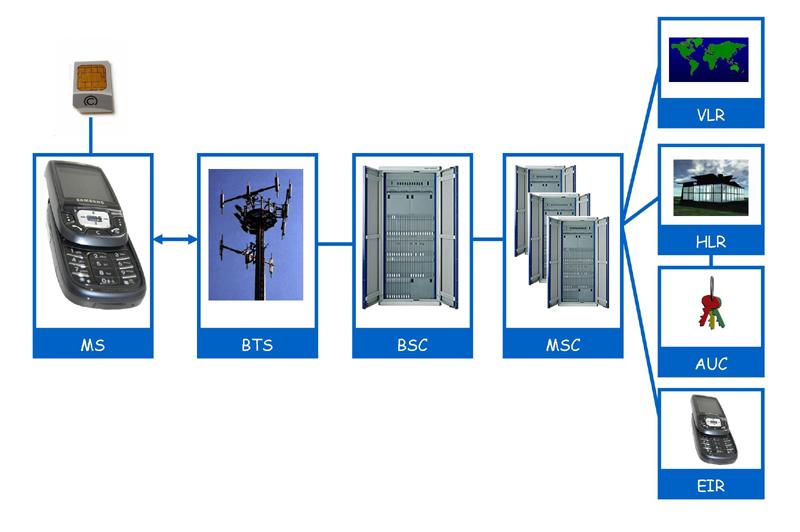As From the Name VLR means Visitor Location Register and HLR means Home Location Register so HLR having all detail of subscriber and VLR having temporary details for mainly call processing related. Let’s check in detail HLR and VLR in Function in telecom.
Hlr and Vlr in Mobile Communication

Home Location Register (HLR) – Main Location of All Database
HLR Full Form – Home Location Register in telecom
Home Location Register – HLR in gsm is main database which save all permanent information about subscriber for network which having billing details, subscriber identity, current status in network and many more for all type of technology either 2g, 3g, 4g or 5g.
The HLR in telecom is the reference database for subscriber parameters. Actually HLR Having all the detail like customer ID, customer number, billing detail and for prepaid with IN intelligent network.
It has detail of current recharge of prepaid user so far its is very complex but i just make it in simple word for you.
Various identification numbers and addresses are stored, as well as authentication parameters. This information is entered into the database by the network provider when a new subscriber is added to the system.
The HLR in telecom database contains the master database of all the subscribers to a GSM PLMN.
The data it contains is remotely accessed by all the MSCs and the VLRs in the network and, although the network may contain more than one HLR, there is only one database record per subscriber – each HLR is therefore handling a portion of the total subscriber database.
The subscriber data may be accessed by either the IMSI or the MSISDN number.
The data can also be accessed by an MSC or a VLR in gsm in a different PLMN, to allow inter-system and inter-country roaming.
HLR in telecom
HLR (Home Location Register) is a database that contains various information about all mobile subscribers in a cellular network, e.g. B. the cell phone numbers, services, whether the numbers have been ported to another network, and similar information.
The Basic Parameters stored in the HLR in telecom are listed below:
list of data stored in HLR
|
|
|
|
|
|
Visitor Location Register (VLR in telecom) – Location of Temporary Database – Instance Access data
VLR Full Form in telecom- Visitor Location Register
Visitor Location Register – VLR is temporary database which save temporary information about subscriber like current subscriber location, subscriber mobile status on or off and many more, vlr is also required in all technology 2g, 3g, 4g and 5g.
The VLR contains a copy of most of the data stored at the HLR. It is, however, temporary data which exists for only as long as the subscriber is “active” in the particular area covered by the VLR.
The VLR database will therefore contain some duplicate data as well as more precise data relevant to the subscriber remaining within the VLR coverage (here coverage means status of customer of last lac location area code updation )
The VLR provides a local database for the subscribers wherever they are physically located within a PLMN, this may or may not be the “home” system.
This function eliminates the need for excessive and time-consuming references to the “home” HLR database.
List of additional data stored in the VLR
|
|
|
|
Location Area Identity in Both HLR and VLR in TELECOM
Cells within the Public Land Mobile Network (PLMN) are grouped together into geographical areas. Each area is assigned a Location Area Identity (LAI), a location area may typically contain 30 cells.
Each VLR controls several LAIs and as a subscriber moves from one LAI to another, the LAI is updated in the VLR.
As the subscriber moves from one VLR to another, the VLR address is updated at the HLR.
Temporary Mobile Subscriber Identity (TMSI) is in VLR
The VLR controls the allocation of new Temporary Mobile Subscriber Identity (TMSI) numbers and notifies them to the HLR. The TMSI will be updated frequently, this makes it very difficult for the call to be traced and therefore provides a high degree of security for the subscriber.
The TMSI may be updated in any of the following situations:
- Call setup.
- On entry to a new LAI.
- On entry to a new VLR.
Mobile Subscriber Roaming Number in VLR
As a subscriber may wish to operate outside its “home” system at some time, the VLR can also allocate a Mobile Station Roaming Number (MSRN).
This number is assigned from a list of numbers held at the VLR (MSC). The MSRN is then used to route the call to the MSC which controls the base station in the MSs Current location.
The database in the VLR can be accessed by the IMSI, the TMSI or the MSRN. Typically there will be one VLR per MSC. thats true behind vlr and hlr in telecom
In general, HLR contains information about all subscribers within a network, while VLR contains more dynamic information relevant to subscribers roaming within the VLR area.
HLR acts as a fixed reference point for a particular mobile station (subscriber), while its VLR can vary depending on mobility and network design.